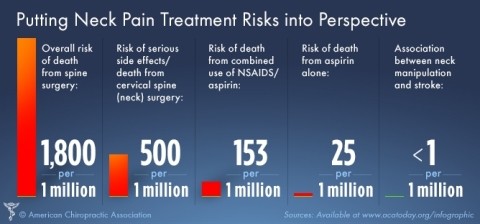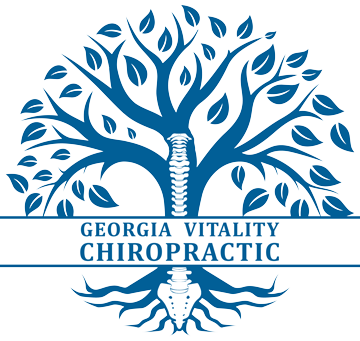Chiropractic Associations Responds to AHA Statement on Neck Manipulation
ICA Review of Scientific Studies Highlights Chiropractic Safety
August 7, 2104, Falls Church, Virginia, US: The International Chiropractors Association (ICA) has undertaken a review of the scientific and clinical literature addressing issues of the safety and effectiveness of chiropractic adjustive procedures and wishes to highlight the unique safety record enjoyed by the profession. This is especially significant in light of frequents news stories, often from less than credible sources, that seek to link chiropractic procedures with some incidence of stroke.
“Medical researchers frequently misunderstand the critical differences between specific chiropractic adjustments and cervical manipulation,” said ICA President Dr. Michael S. McLean. “Doctors of chiropractic are highly trained in the use of the adjustment, which is the specific and scientific application of directional force to facilitate the reduction of nerve interference. Manipulation is the forceful passive movement of a joint beyond its active limit of motion. Since manipulation doesn't imply the use of precision, specificity or the correction of nerve interference, it is not synonymous with chiropractic adjustment.” It is in this context that the ICA offers the following examples of compelling, credible research resources on the chiropractic safety issue:
· A literature review published in the September 2013 issue of the International Journal of Clinical Practice and online at www.medscape.com by P. Tuchin examined 18 studies discussing what the researchers termed "spinal manipulative therapy" (SMT) and stroke to determine if SMT was a causative or associative factor. There have frequently been undocumented rumors of stroke following SMT. Reports not based upon any statistical evidence vary from 1 case in every 400,000 to 1 in 5.6 million. The prejudicial tendencies by some in the medical community toward chiropractic have created controversial, unjustified views of chiropractic SMT having a higher risk of stroke than other types of SMT.
This literature review attempted to cut through the unfounded sensationalism and, "…assess any misconceptions or distortion of the results of studies on chiropractic and stroke." This review noted that sixty percent of strokes occur due to an abnormal amount of lipids (cholesterol and/or fat) in the blood. Smoking, hypertension, obesity, cardiovascular disease, types 1 & 2 diabetes, atrial fibrillation, migraines, heavy drinking, infections, contraceptives, sleep apnea, illicit drug use, and other factors also put a person at higher risk for stroke. Chiropractic adjustments or SMTs are not listed in the scientific literature as a major factor in stroke. The researcher Tuchin explained, "The evidence for causality of vertebral artery dissection from chiropractic is weak."
· The Canadian Medical Association Journal (2001) reviewed the malpractice data from the Canadian Chiropractic Protective Association (CCPA) between 1988 and 1997 on stroke claims following Chiropractic treatment. Results showed that 134 million adjustments were performed and only 23 cases involved stroke. "This most recent study establishes such an extremely low degree of risk that patients can feel confident about the safety of neck manipulations performed by chiropractors," according to Paul Carey, DC, lead author of the study and president of the CCPA. Canadian Medical Association Journal , 2001, 165(7) 905-8.
· A study published in the Journal of the Canadian Chiropractic Association found 13 documented cerebrovascular accidents occurring in chiropractic patients over a five-year period with some 50 million cervical adjustments performed. The author concluded that a reasonable estimate of risk was low at only one per 3 million neck adjustments. [i]
· A review of more than a half-million treatments over a nine-year period at the Canadian Memorial Chiropractic College outpatient clinic found no incidents of strokes . ("Vertebral Artery Syndrome" published in the book "Upper Cervical Syndrome: chiropractic diagnosis and treatment). [ii]
· Not a single case of vertebral artery stroke was found during a study which involved approximately 5 million cervical manipulations from 1965 to 1980 at the National College of Chiropractic Clinic in Chicago. [iii]
ICA understands the emotion, the complexity and the confusion that surrounds these issues at times but believes that the research and actuarial record on this matter demonstrate the exemplary safety record of the chiropractic profession, and, that chiropractic adjustments administered by licensed doctors of chiropractic pose no demonstrable, significant risk of stroke.
All health care professionals must make consumer and patient safety a paramount concern. When the level of risk is quantifiable and significant, providers have a responsibility to offer that data to patients and potential patients. What constitutes a significant level of risk is open to a diverse range of opinions and interpretations; however, to pinpoint risk requires that exact data on causality needs to be present. That causality factor is simply not present and even the coincidental occurrence of injury from upper cervical procedures applied by chiropractors is exceptionally rare, perhaps no more than one per 3 million neck adjustments.
ICA strongly supports full-spine care, including upper cervical procedures as clinically indicated. ICA has come to this position on the basis of an extensive review of both the clinical research record, the outcomes and safety data over the past several decades and the teaching experience offered at chiropractic colleges and in the post-graduate process through ICA’s Council on Upper Cervical Care.
[i] Journal of the Canadian Chiropractic Association , 1993; 37 (2): 104-6

August 07, 2014 04:26 PM Eastern Daylight Time
ARLINGTON, Va.--( BUSINESS WIRE )-- American Chiropractic Association (ACA) President Anthony Hamm, DC, issued the following comment today in response to publication of the American Heart Association/American Stroke Association scientific statement, “Cervical Arterial Dissections and Association with Cervical Manipulative Therapy.”
“Doctors of chiropractic are trained to perform a complete examination, develop a diagnosis and treatment plan, and provide informed consent. ACA members are committed to mitigate the low incidence of CD through education initiatives.”
“The chiropractic profession shares the American Heart Association’s public health goal to reduce the number of strokes; however we have concerns about its statement on cervical manipulative therapy. The real message to all healthcare providers attending to patients with headaches or neck pain is to be vigilant for neurological problems that could be the early signs of stroke.
"The largest and most credible study, Cassidy et al ., found that a patient is as likely to have seen a primary care medical doctor as a doctor of chiropractic prior to experiencing a cervical arterial dissection (CD).
"Neck manipulation is a safe, conservative treatment option for neck pain and headache. The evidence presented in the AHA paper fails to show that neck manipulation is a significant risk factor in CD. In addition, the paper fails to put into context risks associated with other neck pain treatments such as neck surgery, steroid injections and prescription drugs.
"Doctors of chiropractic are trained to perform a complete examination, develop a diagnosis and treatment plan, and provide informed consent. ACA members are committed to mitigate the low incidence of CD through education initiatives.”
The American Chiropractic Association (ACA), based in Arlington, VA, is the largest professional association in the United States advocating for more than 130,000 doctors of chiropractic (DCs), chiropractic assistants (CAs) and chiropractic students. ACA promotes the highest standards of ethics and patient care, contributing to the health and well-being of millions of chiropractic patients. Visit us at www.acatoday.org .
Contacts
American Chiropractic Association (ACA)
Annette Bernat, 703-812-0226
abernat@acatoday.org
See the truth at the following:
- Chiropractic Adjustments Safe According to Scientific Review
- Chiropractors Don't Raise Stroke Risk, Study Says
- Medical Study Demonstrates Chiropractic Safety for Neck Adjustments
- Controversy Over Chiropractic Findings in Medical Journal
- Another Study Shows Safety of Chiropractic
- Chiropractic Safe for Children, Retrospective Study Shows
- Chiropractic Safe for Children - Study Shows
- Study Shows Chiropractic Safe for Post Disc Surgery Patients
- Chiropractic Effective and Safe for Neck Pain According to New Study
- Chiropractic Extremely Safe for Children According to New Study
- Chiropractic Is Safe National Campaign Started
Please visit the website: Chiropractic is Safe .org
